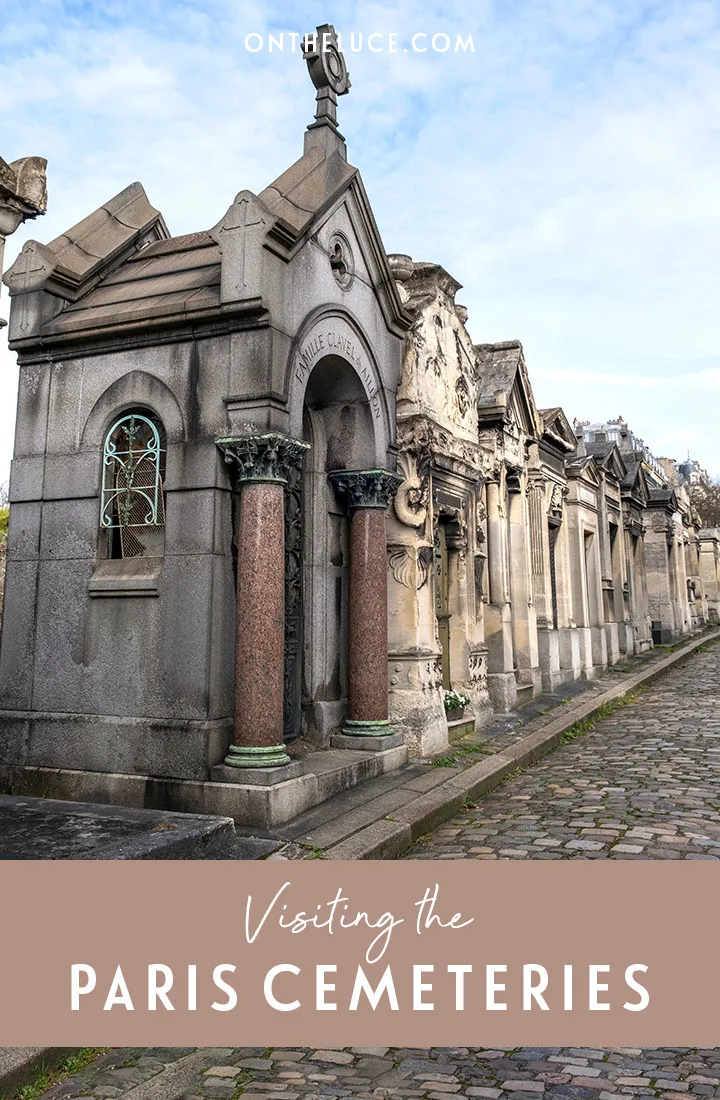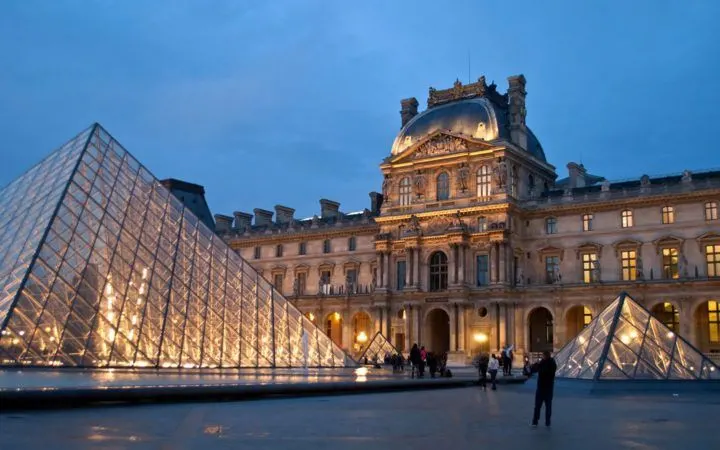Explore Paris’ cities of the dead, four ornate 19th-century Parisian cemeteries which make a peaceful escape from the crowds with their decoratively carved tombs, statues and tree-lined boulevards.
* This site contains affiliate links, where I get a small commission from purchases at no extra cost to you.

A graveyard might not normally top your holiday to-do list, but the cemeteries of Paris are something different. These historic graveyards are a cross between a park and an outdoor art gallery – as well as an insight into the lives of both famous and unknown Parisians.
Acres of parkland have been divided into wide boulevards lined with trees and flowers. And the best artists and sculptors have been commissioned to create beautiful tombs and sculptures, decorated with stained glass, intricate carvings and metalwork.
Cemeteries are almost used like parks by city residents, as a place for a relaxing stroll or even a picnic. Or you can pay your respects to famous names from Oscar Wilde to Jean-Paul Sartre. Free entry means they’re good if you’re visiting Paris on a budget too.
And if you’re in the city on 1 November, La Toussaint (All Saint’s Day) is a national holiday when families across Paris bring chrysanthemums to the graves of their ancestors. The city’s cemeteries bustle with people, bringing new life to these cities of the dead.

About the cemeteries of Paris
From the Middle Ages until the late 18th century, Parisians were buried either in local parish cemeteries or the huge Cimetière des Innocents (Holy Innocents’ Cemetery) near Les Halles. But as the city grew, the cemeteries were penned in by buildings and had no room to grow. And as the bodies piled up, water became polluted and diseases spread.
So in 1780, a law was passed banning any more burials in central Paris. The cemeteries were condemned and all bodies were dug up and moved underground to the catacombs. And in the early 19th century a group of new cemeteries were built outside the city.

These four cemeteries were Montmartre in the north, Père Lachaise in the east, Montparnasse in the south and Passy in the west. And although they were originally built outside Paris, today these neighbourhoods have been incorporated into the city and are easy to access if you are looking for a peaceful escape from the crowds.
These garden cemeteries are almost like parks, with tree-lined streets and ornate graves and tombs with marble statues, wrought-iron decorations and stained glass windows. And they’re especially beautiful in the autumn when the leaves turn gold.

Many graves have been declared historic landmarks, but others might find their final resting place isn’t actually ‘in perpetuity’, as many tombs have carved into them. If your descendants don’t pay for the upkeep of the grave then the site can be resold, with up to 1000 new burials every year, so you’ll often see new tombs mixed in with the old.
Below is a rundown of the four 19th-century cemeteries of Paris, showing you how to get there and taking you through their history and the notable figures buried there.

There’s a map at the entrance of each cemetery which shows you where to find the most famous graves – you can also download a map to help you find your way around (you can find maps here for Père Lachaise, Montparnasse, Montmartre and Passy).
But one of best things about exploring the Paris cemeteries is finding the lesser-known stories. Phones have made it easy to look up people online and learn about their lives when you spot an interesting grave – we came across an air stewardess who died in the Concorde crash, an acrobat-turned-Moulin Rouge owner, and an adult film director.

Père Lachaise cemetery
The Cimetière du Père-Lachaise is Paris’ biggest and busiest cemetery – with over 3.5 million visitors each year it’s the most-visited burial ground in the world.
The cemetery gets its name from King Louis IV’s confessor Père de la Chaise, who had a house on the site where the cemetery’s chapel now stands. It opened in 1804, and originally nobody wanted to be buried there because they thought as it was too far out of the city centre – by the end of its first year there had only been 13 burials.
So in a clever bit of marketing, the graves of playwright Molière, poet La Fontaine and later famous lovers Abélard and Héloïse were moved to Père Lachaise to drum up business. After that its reputation as a burial place for the rich and famous made it the place to be buried for Parisians. And today over a million people are buried in its 110 acres.

Père Lachaise is a city within a city, with divisions marked by street signs. Its inhabitants come from the worlds of art, music, literature, politics and the military. The huge size means it’s easy to get lost though, so you can take a guided walk* or audioguide tour* to discover the stories of those buried here, from the world-famous to the unknown.
You can also pick up a map from shops near the entrance. Away from the famous graves, Père Lachaise is known for its sculptures and ostentatious tombs, as 19th-century families tried to outdo each other with the biggest and best monuments. It’s built on a hill, and the climb up to the top is worth it for the views across the graves and over the city.

Famous graves at Père Lachaise cemetery
Irish poet, playwright and wit Oscar Wilde fled to France after being released from prison and spent his last few years living in St Germain. He was initially buried outside Paris but his body was moved to Père Lachaise, with a sculpture of a naked winged sphinx on top. But his grave is now covered in glass after fans’ lipstick was damaging the stone.
The Doors singer Jim Morrison is also buried in Père Lachaise after he died in Paris aged 27. His grave is covered with graffiti, Jim Beam bottles and cigarettes – and at one point it had to have security guards to stop fans partying around it. Also buried nearby are French singer Édith Piaf of La Vie en Rose fame, and opera soprano Maria Callas.

You can also see the tomb of composer and pianist Frédéric Chopin, with a statue of Euterpe, the muse of music, crying over a broken lute. But he’s minus his heart, which was preserved in alcohol to be sent back to his native Poland as he requested.
- Writers Honoré de Balzac, Collette and Gertrude Stein
- Artists Eugène Delacroix, Camille Pissarro and Amedeo Modigliani
- Actress Sarah Bernhardt
- Dancer and choreographer Isadora Duncan
- Mime artist Marcel Marceau.

How to get to Père Lachaise cemetery
Père Lachaise cemetery has four different entrances. The main entrance is on Boulevard de Ménilmontant close to Philippe Auguste (Line 2) and Père Lachaise (Lines 2 and 3) Métro stations. There are also entrances on Rue des Rondeaux (Gambetta, Lines 3 and 3bis), Rue du Repos and Rue de la Réunion (both closest to Philippe Auguste station).

Montparnasse cemetery
The second-largest cemetery is the Cimetière du Montparnasse – originally known as the Cimetière du Sud. It was built on farmland owned by an order of monks, and you can still see the 17th-century Moulin de la Charité windmill in the graveyard.
The cemetery opened in 1824 and now covers 47 acres with 35,000 graves. It’s split into two sections, with Petit Cimetière on one side of the Rue Emile Richard, and the Grand Cimetière on the other. Wide tree-lined boulevards separate the cemetery into different divisions, and there are metal signposts to help you find your way around.
Montparnasse is the final resting place of many artists and intellectuals – and it has a few unusual monuments mixed in with the traditional tombs and gravestones. Look out for a mosaic cat and mirrored bird, both designed by sculptor Niki de Saint Phalle, a couple lying in a giant four-poster bed and a golden fish on top of an anonymous grave.
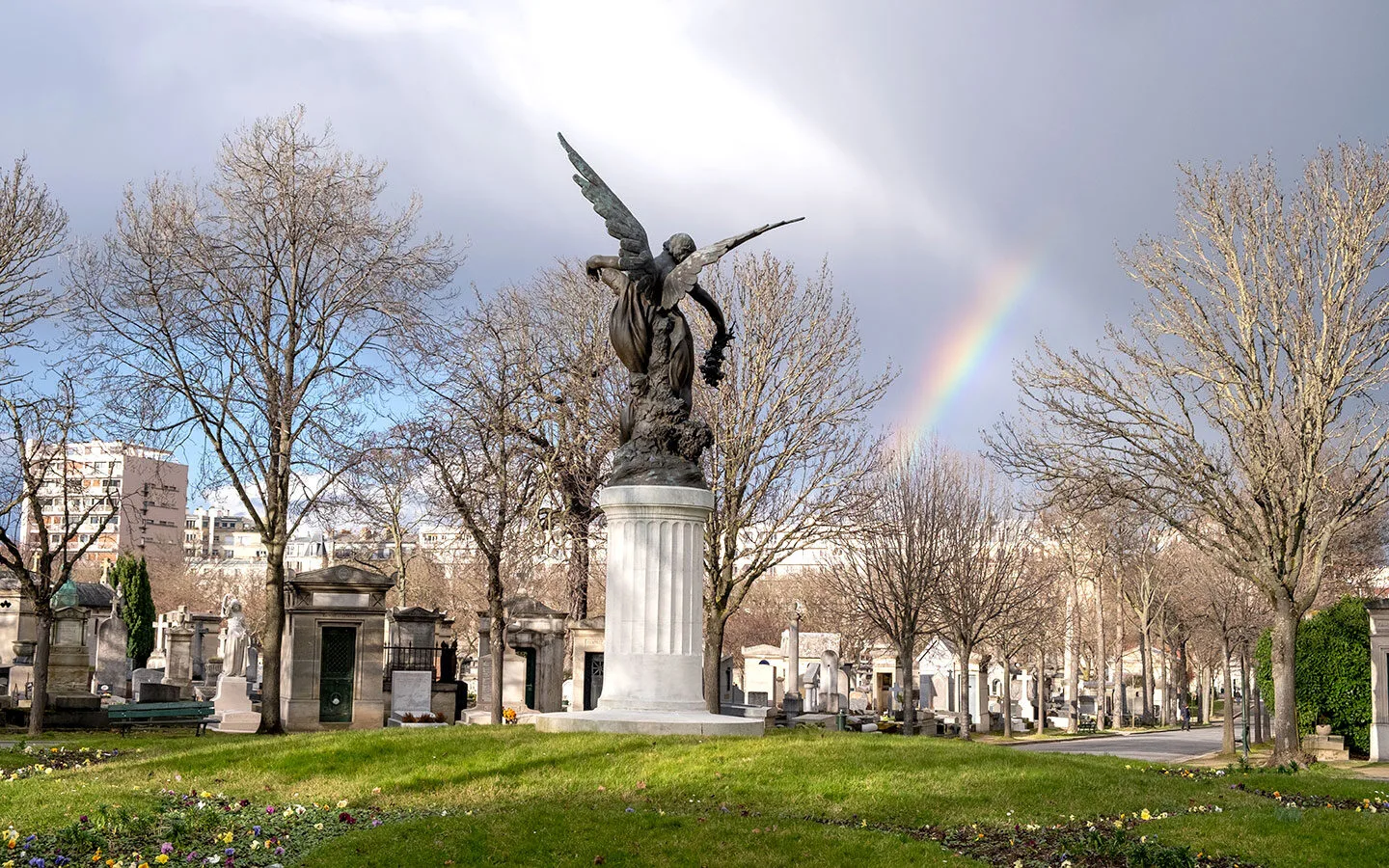
Famous graves at Montparnasse cemetery
Many writers, poets and artists are buried in Montparnasse cemetery, including the husband and wife duo of existentialist philosopher Jean-Paul Sartre and feminist author Simone de Beauvoir. Over 50,000 people lined the streets when Sartre was buried here in 1980, and de Beauvoir was laid to rest with him when she died six years later.
Fans leave flowers, Métro tickets and lipstick marks on their grave as offerings – as well as cigarettes on Serge Gainsbourg’s grave. The iconic French singer and actor, best known for Je t’aime… Moi Non Plus with his on-off partner and muse Jane Birkin, famously smoked five packs of unfiltered Gitanes cigarettes a day before he died in 1991.

Also buried in Montparnasse cemetery is Irish novelist and playwright Samuel Beckett, who lived in Paris for most of his life. He’s buried with his wife Suzanne with a granite gravestone that meets his request for it to be “any colour, so long as it’s grey”.
- French poet Charles Baudelaire
- American writer and critic Susan Sontag
- American Surrealist photographer Man Ray
- Sculptor Frédéric Auguste Bartholdi, who designed the Statue of Liberty
- Former French President Jacques Chirac.
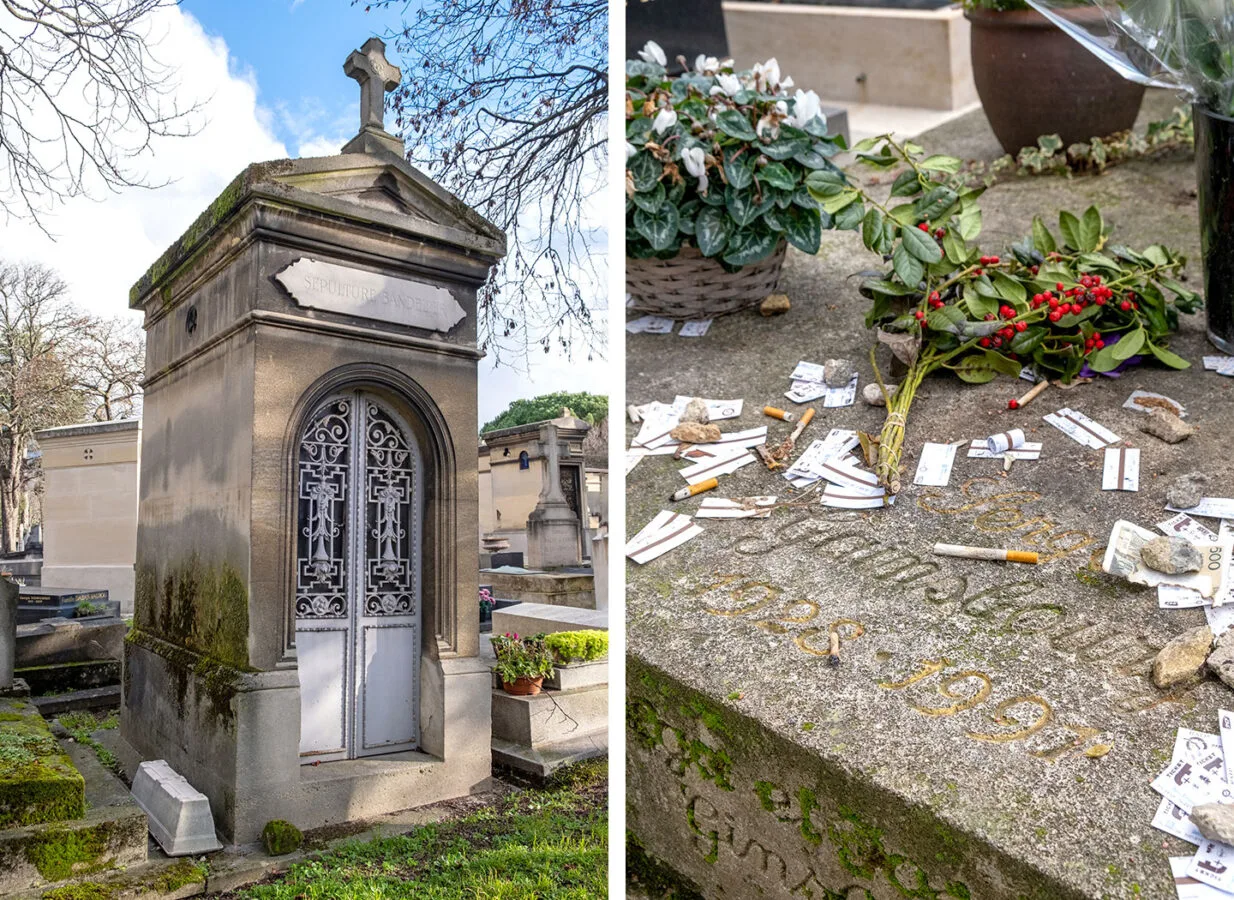
How to get to Montparnasse cemetery
The main entrance to Montparnasse cemetery is on Boulevard Edgar-Quinet, a couple of minutes’ walk from Edgar Quinet (Line 6) and Raspail (Lines 4 and 6) Métro stations. Or slightly further away is Montparnasse Bienvenüe (Lines 4, 6, 12 and 13).
There are also entrances to the cemetery on Rue Froidevaux, which is five minutes away from Denfert-Rochereau Métro station (Lines 4 and 6). This is also where you’ll find another of Paris’ spooky attractions – the underground catacombs.

Montmartre cemetery
Paris’ third cemetery is the Cimetière de Montmartre – or the Cimetière des Grandes Carrières (Cemetery of the Large Quarries). It opened in 1825 on the site of an old gypsum quarry, which was also used as a mass grave during the French Revolution.
The wrought-iron Pont de Caulaincourt bridge runs over the cemetery, which is tucked away below, giving it a secluded feeling. The site covers 27 acres and has 20,000 burial plots. Montmartre has a reputation as a bohemian, artistic neighbourhood, so it’s no surprise over 300 artists, writers, composers and film directors are buried here.
But what makes it my favourite Paris cemetery is that it’s home to over 50 cats. You can spot them prowling the grounds, sunning themselves on top of tombs and watching over the cemetery’s residents. These cats (who are known as ‘free’ not stray) are looked after by an organisation called L’École du Chat, who neuter, register and feed them.
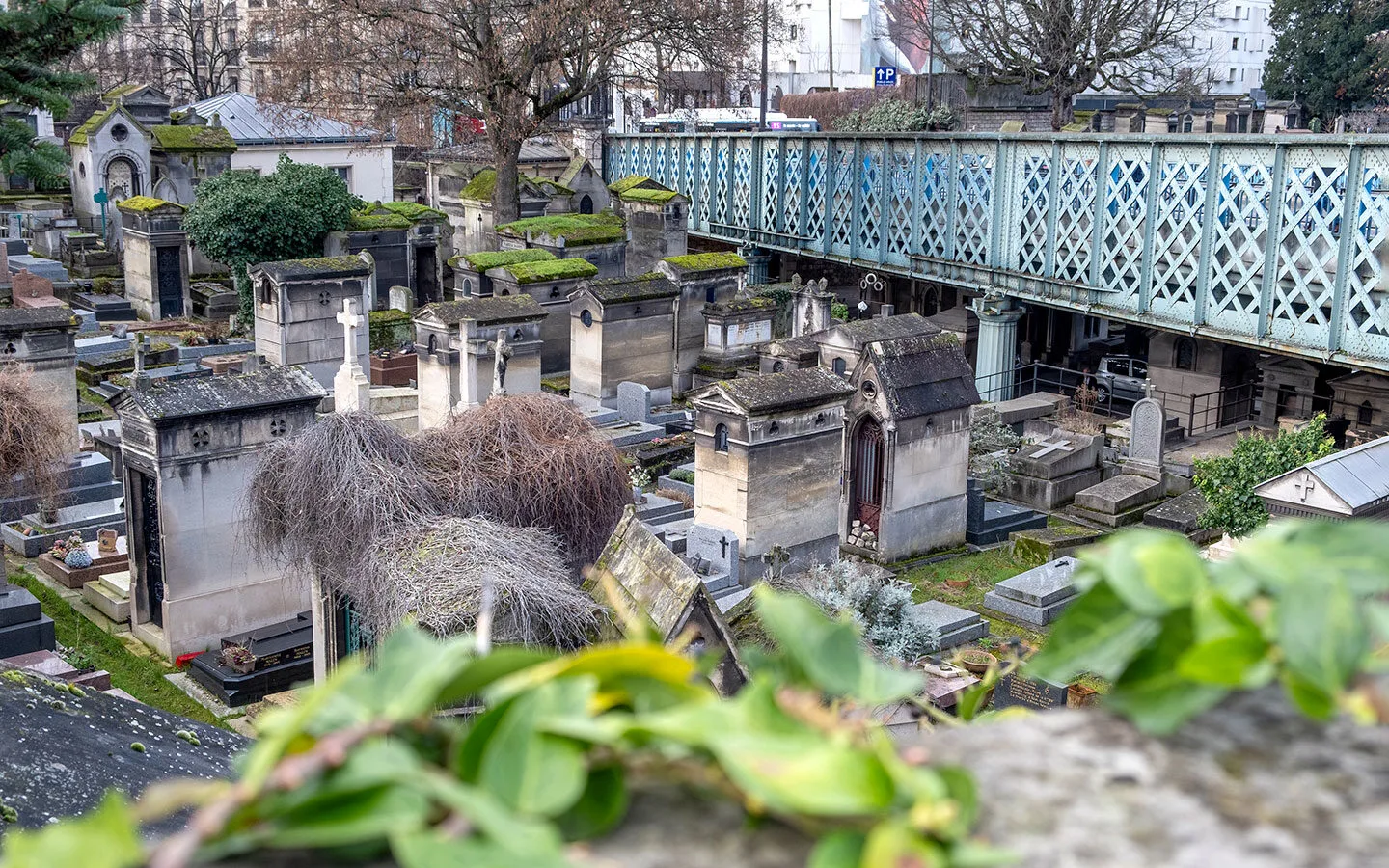
Famous graves at Montmartre cemetery
French novelist Emile Zola died in 1902 from carbon monoxide poisoning – though it’s thought he might have been murdered. Zola was originally buried in Montmartre cemetery and you can still see his memorial, but his remains were later moved to the Pantheon next to Victor Hugo and Alexandre Dumas (whose son is also buried in Montmartre).
Egyptian-born singer Dalida has one of the cemetery’s most impressive graves, with flowers from fans and a life-size sculpture by artist Alain Aslan (who also made the bust of her on display in Montmartre’s Place Dalida). Dalida lived in Montmartre and was a huge star in France, but she had a tragic life and died of an overdose in 1987.

- French impressionist Edgar Degas, known for his paintings of ballet dancers
- Composers Hector Berlioz and Jacques Offenbach
- Physicist Leon Foucault, who proved that the Earth rotates on its axis
- Russian ballet dancer Vaslav Nijinsky, whose grave features a statue of him as the puppet Petruschka
- La Goulue, a dancer at the Moulin Rouge who invented the cancan.

How to get to Montmartre cemetery
The entrance to Montmartre cemetery is on Avenue Rachel, which you can reach via a flight of stairs from Rue Caulaincourt. The closest Métro stations are Place de Clichy (Lines 2 and 13) and Blanche (Line 2), both of which are around five minutes’ walk away.
If you want to explore more of Montmartre, you can start our free self-guided walking tour from Blanche Métro station. It covers 2.5km (1.6 miles) and includes the Moulin de la Galette, Clos de Montmartre vineyard, Place du Tertre and Sacré-Cœur Basilica.

Passy cemetery
Despite being right next to the Place du Trocadéro with a view of the Eiffel Tower, the Cimetière de Passy is the smallest and quietest of our four Paris cemeteries. It’s tucked away behind a high wall so you can easily miss it, but it’s well worth a visit.
Passy cemetery opened in 1820 and was extended several times. But it’s still fairly small with only 2600 graves. Passy was a wealthy neighbourhood though so it has some impressive sculptures and monuments, with paths lined with horse chestnut trees. It was also the only cemetery in Paris with a heated waiting room for its classy clientele.

Famous graves at Passy cemetery
Many of the wealthy aristocratic families who lived in Passy are also buried in Passy cemetery. So you can see famous family names like Renault, Givenchy and Guerlain, and there are also members of royal families from Russia, Monaco and Iran.
Among the grand mausoleums and tombs, look out for the unusual grave of Hungarian politician Baron Pierre de Perenyi. On top is a white marble replica of the Pietà by Michelangelo. The original is on display at Saint Peter’s Basilica in Vatican City, but this mini version is encased inside a clear perspex box to stop it getting damaged.

- Composer Claude Debussy, who wrote Clair de Lune
- French Modernist painter Édouard Manet
- Bảo Đại, the last Emperor of Vietnam
- American silent film actress Pearl White
- Ernest and Marie-Louise Cognacq-Jay, founders of La Samaritaine department store, whose art collection is on display at the Musée Cognacq–Jay in the Marais.
How to get to Passy cemetery
The entrance to Passy cemetery is on Rue du Commandant Schloesing, across the street from the Palais de Chaillot. The nearest Métro station is Trocadéro (Lines 6 and 9).

Save for later

